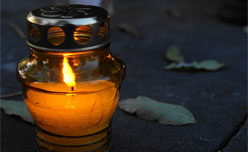All Saints’ Day celebrations in different countries
In all churches of the Western Christian denomination, the end of October and the beginning of November are marked by the celebrations of the Hallowtide, a three-day long observance of All Saints’ Eve on 31 October, All Saints’ Day, on 1 November and All Souls’ Day, on 2 November.
Hallowtide stems from the Christian tradition of honouring the martyrs, the known ones, as John the Baptist, as well as the unknown ones. Having consisted initially of only festive days, the All Saints Day and All Saint’ Eve, Hallowtide was extended, in the 8th century by one more day, dedicated to celebration of all the departed. The All Souls’ Day, in some countries commonly referred to as the Day of the Dead, is an occasion commemorating the deceased ones, in particular, the relatives.
The celebrations of Hallowtide take different forms in different cultures, especially in respect to the last day of the triduum. Whereas in some countries All Souls’ Day is a very solemn an introspective occasion, bringing people to the cemeteries, where their bellowed ones are buried, in other parts of the globe, the same day calls for a joyful festivities, being the Mexican Fiesta de Los Muertos the best example. Regardless of the character of celebrations, what Hallowtide has in common across the world is that at least one of its days is considered a public holiday.

All Saints’ Day is a joyful celebration in Mexico
Halloween celebration – 31 October
In popular culture, the best known form of Hallowtide celebrations is the American tradition of Halloween which has been adapted by many countries worldwide, regardless of the religious convictions.
Known for scary costumes, carved pumpkins and trick-or-treating, Halloween is observed on 31 of October. According to some theories, Halloween celebrations derive from ancient pagan traditions, namely the Celtic harvest festival.
Although there are records of Halloween being observed in the United States already in the early days of the British colonization of the north-American continent, the tradition gained popularity, becoming a nation-wide celebration with the arrival of immigrants from Ireland and Scotland to the US in the 19th and 20th centuries.
All Saints Day in Portugal – 1 of November
Known in Portuguese as Dia de Todos os Santos, the All Saints’ Day is the most important celebration of the Hallowtide in Portugal, being 1 of November a public holiday (although removed from the list of Portuguese bank holidays between 2013 and 2015, in attempt to reduce the impact of the economic crisis).
Special services are held in the churches on 1 of November and visits to the cemeteries to light candles on the graves of the relatives are common on both 1 and 2 of November.
In rural areas of Portugal, an ancient All Saints Day tradition is still preserved. Known as ‘Pão por Deus’, or ‘Bread for God’, the tradition consists of children visiting the houses within the village to ask for treats or money, much in the resemblance of the Halloween trick-or-treating. Originally, only bread or cakes baked according to a special recipe were offered; nowadays however, sweets are more common.
Fiesta de Los Muertos – 1 and 2 of November
The probably most unusual All Saints’ Day celebrations take place in Mexico, during the first two days of November.
Combining the Catholic and the ancient Aztec traditions, on 1 of November, the Mexicans built at their homes colourful altars where the offers for the dead are placed, including a selection of traditional foods, as well as toys and sweets for the ‘angelitos’ – children and tobacco and spirits for the adult deceased.
The festivities of the Day of the Dead are an extremely joyful and accompanied by parties, music and folk dances. As much as an opportunity to reminiscent about the dead, it is a celebration of life itself.
Unsurprisingly, skeletons and sculls are the main motif of the Fiesta de Los Muertos. Sugar sculls (in more modern version also chocolate sculls) are sold, offered and submitted for competitions for the most beautifully decorated one.
On 2 November, the ‘party’ moves to the cemeteries and continues throughout the night. Although commonly associated with Mexico, the Day of the Dead is celebrated in several Latin American countries.


